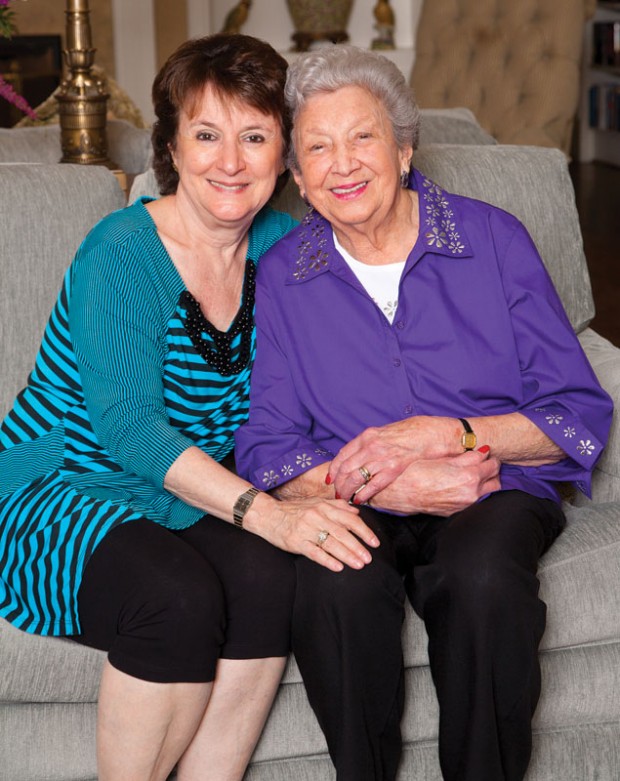When an Aging Parent Lives Far Away


Diane Searcy, left, helped move her mother, Nonie Schatzman, 94, from New Jersey to Houston to be closer to her family. (Photo: lawellphoto.com)
Marge’s mom has always been sharp mentally. She was a therapist who ran her own practice, and she always has loved going to plays, operas and the orchestra, playing bridge and meeting the gals out on the town.
Then, in January 2012, she had a “cardiac event” during which her brain was deprived of oxygen. Ever since, Marge said, she’s been different.
Now, the 76-year-old woman talks about events that happened months ago as though they happened yesterday. Her eyesight is bad because of diabetes. She gets lost when she drives, forgets a lot, falls frequently and has problems with bladder control. But she doesn’t think there is cause for concern.
And because Marge lives more than 1,500 miles away in Houston, there’s little she can do to keep a close watch on her mother. Because her husband, Marge’s stepfather, refuses to move, her mother refuses to move, too.
But Marge’s stepfather, like Marge and her siblings, won’t confront her because of fears her mom will shut them out and turn hostile toward them.
“She’s like a child now and shouldn’t be making decisions, but she’s making decisions because everyone around her is afraid to pull the plug and take away her keys,” said Marge (not her real name).
Occasionally, Marge, a mother who has a part-time job, travels to her mom’s home to “put out fires” and schedule doctor’s appointments. The rest of the time, she hires social workers, in-home care givers, counselors and occupational therapists to help. But when they start talking to her mother about her driving problems, she kicks them out of her house.
“The best I can do with her living up there is damage control,” Marge said. “Every day that goes by that I don’t get a call that something’s happened to her, or she’s not on a missing person’s report, I feel like we’ve had success.”
Convincing an aging parent to move can be difficult, if not impossible, experts say. And there’s a fine line – the child needs to respect the parent’s decision to live his or her own life. But before that decision is made, experts say a psychological evaluation by a neurologist is needed to determine if the parent is mentally capable.
Just because an elderly parent forgets to pay a bill or forgets a lunch date yesterday doesn’t indicate diminished capacity, said Jeannette Lazarofsky, a geriatric-care manager who has worked in the aging industry for 30 years and owns JML Geriatric Care Consulting in Houston.
While older people may take longer to recall information, they should still have the powers of retention and recall, said Dr. Bhuvana Muthuswamy, an internist with Houston Methodist Primary Care Group. Just because they’re aging doesn’t mean they should lose their memory, he says. There are other “red flags” – see a list in the box on the next page – that the parent is no longer capable of independent living and may be a danger to self or others.
In those cases, the adult child – who often is geographically tied down by employment and/or children’s schools – will need to step in and, sometimes, insist on the parent moving to a nearby apartment or retirement community.
The conversation should start early, said Abi Pineda, a social worker with Memorial Hermann Southwest Hospital. Have an advance directive, a living will, a last testament and a power of attorney. Lay out when the child can take control of the parent’s care.
If it’s too late for that, the adult child can hire a geriatric case manager or accredited case manager to act as an intermediary, which will cost $150-$400, Pineda said.
Asking the parent’s doctor to talk to him or her can be helpful, Lazarofsky said, as can framing the move as though it’s a favor to you. A short visit or “snow bird” stay through the winter can help. Then you can tour retirement centers together.
The Village of Tanglewood, like most retirement communities, lets prospective clients share meals, participate in programs and even spend a weekend in the model apartment, said Diann DiFrancesco, regional director of operations.
Convincing Nonie Schatzman to move from her lifelong home town of Passaic, New Jersey, to the Village of Tanglewood five years ago wasn’t too hard, said her daughter Diane Searcy. She let Schatzman make the decision for herself.
“You can’t just go in and say, ‘You’re moving now,’” Searcy said.
At the time, Schatzman lived in the upstairs portion of a two-family home, and her brother, who lived downstairs, was selling his half. Diane pointed out how dangerous it could be for Schatzman, then in her late 80s, to continue climbing those stairs in the snowy New Jersey winters. Schatzman toured apartments near her home but didn’t like any, and most of her friends had left or died.
Schatzman admits she didn’t want to leave, initially. She was devastated to leave the home she’d lived in for 55 years. But she didn’t know where she was going to go, and she cried herself to sleep for five consecutive nights before her daughter called and suggested she moved down here close to her. Searcy encouraged her mom to come, reminding her how she’d taken care of her own aging mother, and how she hadn’t felt like that was a burden.
One of Schatzman’s daughter’s lives in Boston, and her son lives in San Francisco. The children decided it would be best for her to live in Houston with Searcy because of the reasonable housing options and because her grandchildren were here.
When the suggestion was made, Schatzman said, it was a relief. “I had no choice,” she said. “But if I had an option to go back, I wouldn’t.”
She hasn’t given up all the trappings of her old life. She still has pots and pans “out the wazoo,” Searcy said, even though she doesn’t use them much. She does make lunch for herself, mostly salads, soup or tuna fish. But she wants to be able cook if she chooses to.
Schatzman sees her daughter and grandchildren regularly now – she didn’t when she lived in New Jersey – and has made new friends. She plays dominoes and other games, something she didn’t do when she and her husband, Jack, ran a hardware store for more than 40 years. Searcy believes her mother would be isolated if she still lived by herself in New Jersey.
Schatzman, now 94, is the picture of health. She takes only one pill, for blood pressure, and she uses a walker to walk around the halls at The Village four times a day.
She has fallen four times since moving to Houston, though, and has gotten immediate help. Searcy fears that if Schatzman had still lived in New Jersey, it might have been days before someone found her. Certainly, it would have taken more planning and effort for Searcy to go check on her after the falls.
“She’s where she’s safe, and that means a lot to her and a lot to me,” Searcy said.
But in cases like this, the elderly parent doesn’t always come to the decision that it’s best to move. If necessary, adult children can take the neurologist’s assessment to court and sue for guardianship. Or, they can compromise and focus on setting up the parent’s current home and environment to be as safe as possible.
Sharon (not her real name) moved her mother, Patty, into The Hampton at Post Oak after her mother fell and broke her hip. Sharon wishes she’d moved her sooner. They had 10 years together before her mother died in January. They spent time together, and her son got to know his grandmother.
But Patty wasn’t the same woman she’d been before her fall, and she didn’t develop the friends or make the neighborhood connections she would have made if she had been more mobile when she arrived.
Still, for Sharon, it was the right decision.
“You’ll never regret any time you spend with an aging parent,” she said. “I’m just truly sad that I didn’t do it when Mother was in better shape.”
Red flags, resources and tips
Red flags
It can be hard to determine a person’s mental state over the phone. But here are some signs that could indicate an elderly parent is having some cognitive issues and may need you to visit and, if necessary, schedule a psychiatric evaluation to determine capacity for independence:Not paying bills. Not taking pills. Getting into auto accidents. Sounding withdrawn or not engaging in their usual interests and hobbies, which could indicate they’re depressed. Giving money away. Out of character during phone conversations. Talking about the past as if it’s the present. Talking about dead people as though they’re alive. Paranoia. Calls from a neighbor. A recent fall. Hearing loss. Vision loss.
Resources
• Adult Protective Services, which investigates abuse, neglect and exploitation of elderly or disabled adults. www.dfps.state.tx.us/Adult_Protection
• Newlifestyles.com – an online guide for senior living and care options
• Eldercare.gov – connects to local resources for older adults
• nia.nih.gov/health/featured/caregiving – articles on caring for an older adult
• Caremanager.org – to locate a local geriatric-care manager
• Nasmm.org – the National Association of Senior Move Managers. Move managers help older adults with downsizing and moving.
• University of Texas Center for Healthy Aging in Bellaire, which provides services for seniors. 713-486-5150. uth.edu/aging/patients/Bellaire
• Memorial Hermann Southwest Hospital Senior Medicine Unit, with two social workers and 24 beds dedicated to people 65 and older, plus a Senior Emergency Center. http://www.memorialhermann.org/locations/southwest/senior-care/
• Methodist Hospital Geriatrics Division – provides in-hospital services to seniors. 713-790-3333
• Strategies to help a parent who refuses care – care.com/senior-care-9-strategies-to-help-a-parent-who-refuses-care-p1017-q7117625.htmlMaking the move
After you’ve convinced Mom or Dad to move comes the daunting task: the move itself.Cynthia Williams, owner of Transitions: Making Moves Manageable, recommends reaching out to a member (like herself) of the National Association of Senior Move Managers. Those movers are licensed and insured and can ease the process, she said.
The process includes making a detailed drawing with measurements of all the furniture and diagramming that furniture into the new apartment to see what fits. She suggests taking photographs so you can put things in roughly the same place in the new location to create a greater sense of comfort.
Williams recommends starting at the far left side of the house and working your way to the right, going through everything – the bookshelves, cabinets, floor and more.
Items that can’t fit can go to family members, housekeepers or yard workers, a consignment store or, if valuable, to an auction. Then, clean up the house and get it ready for the realtor.
Want more buzz like this? Sign up for our Morning Buzz emails.
To leave a comment, please log in or create an account with The Buzz Magazines, Disqus, Facebook, or Twitter. Or you may post as a guest.


